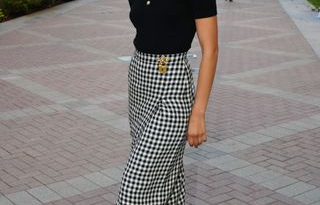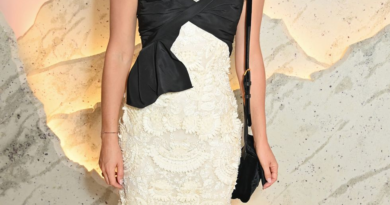<i>Barbie</i>’s Final Joke Is Also Its Most Meaningful Lesson
Spoilers below.
Barbie is not a mother, unless you count the millions of young girls she’s shaped in her image—whom, of course, you must count. Barbie the movie, director Greta Gerwig’s record-breaking box-office hit, takes this contradiction seriously, in so far as any film combining corporate branding, cellulite, Matchbox Twenty, and death can take itself seriously. Barbie was never meant to be a mother; the pregnant doll Mattel invented as a proxy for Barbie was Happy Family Midge, whose removable-baby belly was condemned for “promoting” teen pregnancy. As narrator Helen Mirren informs audiences in the opening scenes of Barbie, Midge was discontinued for being “too weird,” apparently too difficult to reconcile with childhood imagination. Barbie herself has remained smooth and ageless and, importantly, without reproductive organs of any kind for the entirety of her 64 years on Mattel’s factory line. Which is exactly why the Barbie movie’s ending is so delightfully subversive.
Anyone, and certainly any woman—whether cis, trans, or otherwise—or non-binary person, will tell you that genitals mean a great deal to a great number of people, regardless of whether or not they should. Within hours of Margot Robbie’s Stereotypical Barbie stepping into Barbie’s “Real World,” she enlightens a group of men heckling her with the simple truth that she has no genitals, and neither does Ken—so, hey, the joke’s on them. This fact does not seem to bother Barbie herself; it is Ken, rather, who appears humiliated by the revelation.
The film tickles these gendered defenses until they collapse, culminating in a confrontation in Barbie Land between the recently brainwashed Barbies and the newly educated Kens, who’ve decided to bring patriarchy back to Barbie Land in the form of beer and horses and the vocal inflections of Rob Thomas. But the fight does not end with Barbie restoring the Great Feminist Order to her world, where the Kens are free to beach each other off into oblivion; instead, she realizes just how flawed her understanding of gender was from the beginning.
She meets, once again, with her creator, Ruth Handler (as portrayed by Rhea Perlman), who takes her betwixt the membranes of the Real World and Barbie Land. This dimension—wherever or whatever it might be—has no clear beginning or end. It is the hazy white room of the In Between. I’d go so far as to say it’s an allegorical in-utero, its inhabitants not yet born but undeniably real, floating in contested territory. Here, Ruth presents Barbie with a deeper version of the choice first posited by Kate McKinnon’s Weird Barbie at the beginning of the film: Stay and remain one-dimensional, or leave and embrace chaos. Ruth makes the perils of this choice obvious. If Barbie stays, she’ll forever mimic a version of perfection she no longer believes in. If she leaves, she will no longer be an idea but a creature, one that can live but can also die. Her arched footprint will no longer be ideological but material, and the consequences will be much harder to ignore.
“We mothers stand still so our daughters can look back to see how far they’ve come,” Ruth tells Barbie, in one of the film’s more fascinating lines. She is referencing, of course, her relationship to her own daughter—Barbara Handler, whom Barbie was named after. But she is also referencing Barbie herself, whom Ruth imagined and designed and fought for and sold. By “looking back” at the found-footage sequence Ruth then presents, as if through a prophetic vision, Barbie can see how far she has come, both in the context of the film itself and in the greater cultural imagination over her six decades of iconography. Barbie means something different to a modern era than she did to the children of 1959. But she continues to influence them; she continues to raise them. It is a beautiful, complicated thing, just like the slices of life displayed in the home videos. And it poses a great responsibility, to which Barbie accepts the challenge. “Yes.”
Yet the film does not end here. The actual ending of Barbie takes place in one final sequence, as Barbie’s new human family (including America Ferrera’s Gloria and Ariana Greenblatt’s Sasha) drops her off at an unmarked office building. We don’t know exactly where Barbie is, only that she’s preparing for a momentous occasion in the Real World. Perhaps a job interview? Maybe the DMV? Gerwig gives us one last smirk as Barbie marches up to the front desk and announces, “I’m here to see my gynecologist.”
It’s a last laugh for the ages. But what makes it such a perfect line to end with is not only its humor but its significance. Barbie is a human now. She has, we can assume, human organs. The specific nature of those organs doesn’t matter. The mechanics of how she received these organs doesn’t matter either, no more than it mattered how Barbie could magically float from her rooftop to her pink Corvette any time a child picked her up to play. What matters is that she now carries the hallmarks of human womanhood, and she must learn how to live with them.
Now, I think it’s important to note here what Gerwig is not saying: that womanhood or motherhood are designated purely by the status of one’s reproductive organs. Rather, I believe she’s alluding to the opposite: that such statuses are complicated, such organs are complicated, and that they should be—because the complexity of humanity is a source of its beauty. At the end of the film, Stereotypical Barbie takes her first step to embracing that complexity by waltzing into a historic human institution of care and confusion, pleasure and pain: the gynecologist’s office.
As the daughter of a gynecologist, I have long associated my mother’s workplace with both the unsettling smell of antiseptic and the warmth of her laugh echoing from the examination room. I am not yet a mother, but I have one, and I have walked (and played) in the corridors where so many mothers are made—biological, adoptive, figurative, and otherwise. It should go without saying that Barbie does not need genitals to be a mother, nor does she need to give birth to have influence. But by giving Barbie organs, and by taking her to the place where such organs are cared for, Gerwig plants Barbie firmly in the complexity of our own human experiences. She is held up not just as an icon of our dreams (and insecurities), but as a mirror to our lived reality. There is enormous power in such an act, particularly for a corporate brand that has wielded such power over children’s aspirations.
As many critics have already pointed out, Barbie can’t fix Barbie. The film itself is flawed, compromised by its own subject matter and an explosive marketing campaign. There are parts of the movie I wish dug deeper, hit harder, and stayed longer. But I will remember that ending. I will remember the way it presented Barbie as a mother—not because she has organs, or children, or even a good gynecologist, but because she is so happy to be gloriously, undeniably human, and she wants to share that feeling with us. Going to the gynecologist is the best part of her day! She has raised so many around her; to see her thrilled to embrace the messy reality of womanhood gives us permission to do the same. Like Ruth, she seems to demand we turn around and assess how far we’ve come.
Culture Writer
Lauren Puckett-Pope is a staff culture writer at ELLE, where she primarily covers film, television and books. She was previously an associate editor at ELLE.





